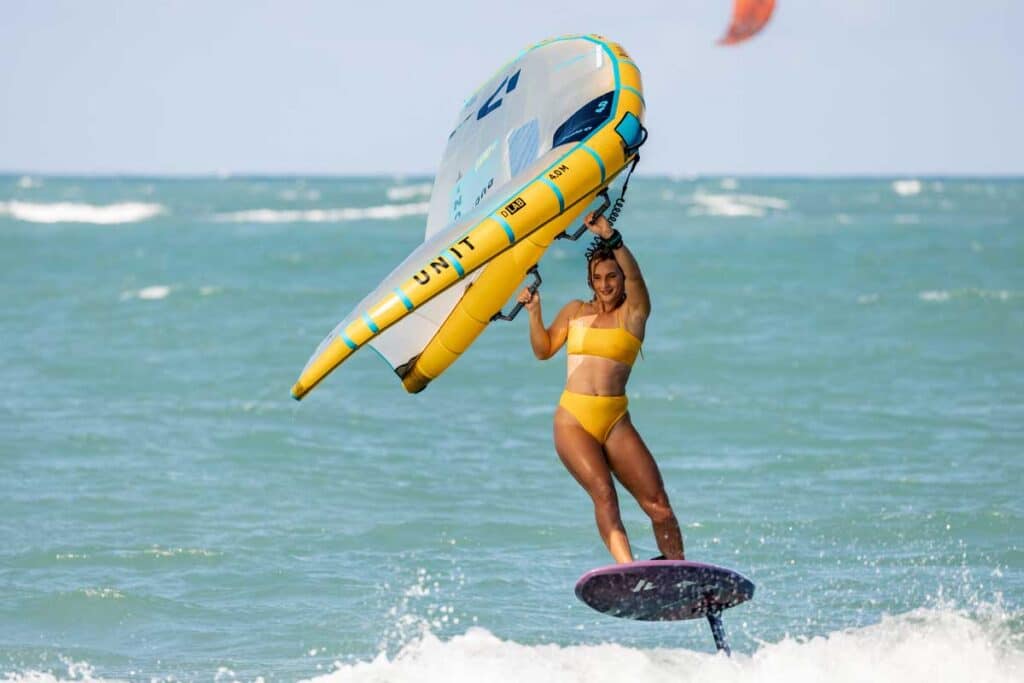
As it is with wingfoil tacking, the exciting and essential skill of wingfoil jibing has two fundamental flows: heel-side to toe-side and toe-side to heel-side. Presuming you are new to jibing, the best starting point is the heel-side to toe-side transition. This involves riding with your front foot forward and executing a seamless turn into the “switch” position (toe-side), which eliminates the need to change your feet during the jibe.
Step 1: Get comfortable with the foil
First, let’s get you comfortable with that foil beneath you. Imagine the little plane below the surface—you must know how to control it. It will instantly respond to your every weight movement. Bigger foils that are ideal for learning are more forgiving and will allow you to have some more time to put it all together, so I definitely recommend starting with big gear in the beginning of your wingfoil journey.
Let’s practice for the jibe by riding heel-side and practicing subtle turns to the left and right. This will help you get a sense of the control needed for the jibe, which you will initiate by shifting your weight from your toes to your heels.
When transitioning to toe-side, the key is to shift your weight forward, leaning onto your front foot. This adjustment is the secret sauce for maintaining that perfect balance and control during your turn. To master riding toe-side, you have two options: initiating a jibe into toe-side or switching your feet while riding. The choice is yours.
Whether you’re switching from toe-side to heel-side, or the other way around, it all starts with lifting the front of your board. As you do this, shift more weight onto your back foot and swiftly switch your foot positioning. This ninja move ensures your board stays perfectly balanced throughout the entire maneuver. Don’t forget, the wing above your head can act as your wingman, providing that extra lift when you need it.
Step 2: Master the heel-side to toe-side jibe
Many wingfoilers consider this type of jibe to be the easiest, making it the perfect starting point for newcomers. Entering the heel-side to toe-side jibe you want to first generate additional speed. To do so, just before making the turn, pull on your back hand to grab some power in the wing. Then, transition to holding the wing high overhead. Keeping the wing elevated will help you master this move. Now, carve your turn to point the front of your board downwind. Shift your weight onto your toes and bring your hips forward. Then, release your back hand from the wing. Allow your board to keep turning while your wing is still high above. Simultaneously, switch your hands and start pulling on the back hand again to power the wing. Finish the maneuver by pumping the wing and the board a bit if your speed drops during the jibe.
Step 3: Move on to the toe-side to heel-side jibe
This second style of jibing has similar steps, but is a little bit more difficult to start with. I believe once you master the heel-side to toe-side jibe, this jibe will be much easier to handle.
Let’s get to it. Build speed before starting the jibe by pulling on your back hand slightly more to power the wing. Now hover your wing overhead as you initiate the turn. Keeping your wing high will help you have more balance. Release your back hand as you begin carving your board downwind while transferring your weight onto your heels.
As the board turns, switch your hand on the top handle, or on the top of the boom. The key moment is when you’re completing the maneuver, swiftly pull back on your back hand to catch the wind and maintain your speed as you exit the jibe. If you need more speed, you will need to pump the board slightly to continue flying.
By mastering both heel-side to toe-side and toe-side to heel-side jibes, you’ll unlock a world of control and excitement in your wingfoiling skills. Mastering the switch of your feet while riding is also another next-level achievement. Always remember: practice, practice, practice and be patient. It all takes time, but let me tell you it is worth it.
Paula Novotna @paulanovotna is the first-ever women’s world champion in wingfoiling, excelling in both freestyle and racing. Follow her journey on her social media channels, including Instagram, Tiktok, Youtube, and Facebook. She’s here to inspire and share her experiences with you to become a better wingfoiler.









